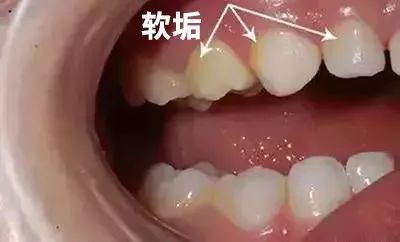Do you know what the problem is with the children’s teeth above? Caries? Tartar? These black things on children’s teeth are actually “pigments”. Children usually start to have a lot of soft plaque and pigments on their teeth when they are 2-6 years old. If left unattended, they will develop into caries and threaten children’s oral health.
What is children’s teeth pigmentation?
As shown in the picture below, the yellow part is soft plaque, and the black part is pigment, which is a kind of pigment deposition.
The surface of children’s teeth is not smooth. Food residues and pigments are easily deposited in the uneven grooves of teeth. Conventional brushing cannot clean these residues and pigments. Over time, these black (yellow) spots will appear on the teeth, and melanin will remain.

Caries and melanin deposition are so similar, how should friends distinguish between the two?
The key is whether the dirt and plaque have damaged the tooth body and eroded the inside of the tooth.
◎ Tooth decay: dental plaque has eroded into the inside of the teeth, the protective layer has been destroyed, and the tooth body is damaged.
◎ Pigmentation: dirt is only formed on the surface of the teeth, and the protective layer has not been destroyed.
What causes pigmentation?
Dietary structure, frequent consumption of pigmented foods or beverages. The longer the contact time between food pigments, sugars and teeth, the easier it is to cause pigmentation. Children are unrestrained in eating sweets such as cakes, candies, and beverages, and are careless in oral cleaning, which can easily lead to pigmentation and soft scale residues.
Toothbrushing habits, careless or incorrect brushing. Children should rinse their mouths or brush their teeth after meals when they have deciduous teeth or their teeth have not yet grown. Careless brushing habits will cause the pigments in the food to adhere to the tooth surface for a long time after eating, which is very easy to breed bacteria and melanin.
Drug reasons, eating Chinese medicine, iron supplements and other pigment drugs. Children take pigment drugs because of physical nutrition reasons, forming a bacterial environment that is easy to deposit pigments, leading to melanin.
How to remove or avoid these melanin?
- Children’s teeth cleaning
Don’t think that only adults can clean their teeth, children can also do it.
So how should children clean their teeth?
Children aged 2-6 rarely have dental calculus, but there are more soft plaque and pigments. Dentists will use a very gentle low-speed brush or polishing method to remove them, and then use dental floss to clean each tooth gap of the child.
The so-called polishing is to use a soft rubber cup with a fruit-flavored polishing paste that children like to polish and clean the surface of the teeth to remove soft plaque and pigments, so as to achieve the purpose of protecting teeth.
- Pit and fissure sealing
There are many tiny cracks and pits on the surface of children’s teeth, which are easy to hide dirt and dirt, and it is difficult to clean them thoroughly by brushing.
The principle of pit and fissure sealing is to apply a harmless resin to the pits and fissures of the teeth. After curing, it is like putting a layer of protective clothing on the teeth. Prevent excessive deposition of melanin, leading to continuous erosion of plaque and tooth decay.
- Fluoride protection
The enamel of deciduous teeth has a low mineralization level and is less able to defend against melanin deposition. You can take your child to the dentist to apply a layer of protective fluoride to the teeth to resist the threat of “sugar-coated bullets”.
